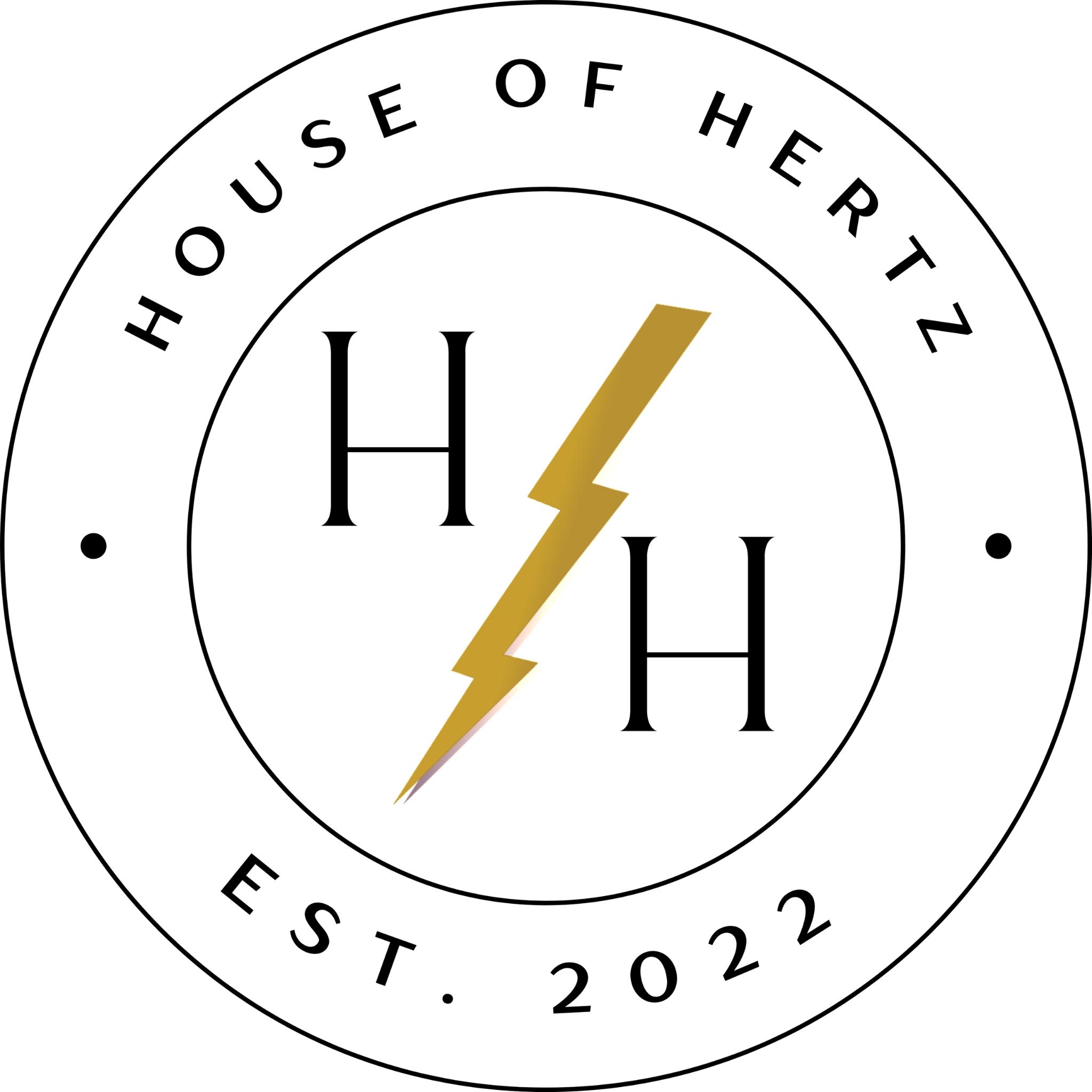

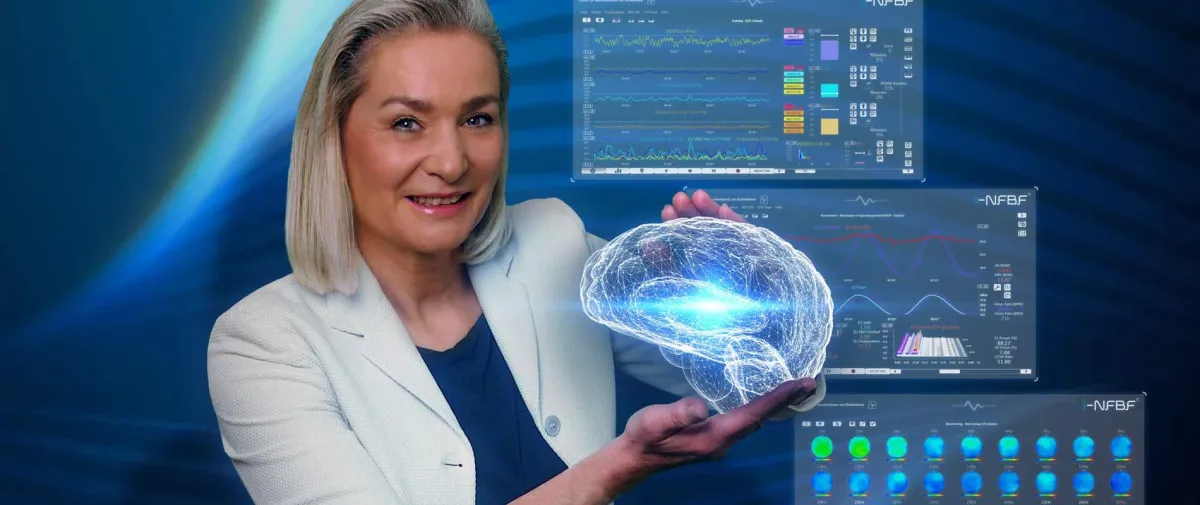
Introduction of the Institute of Neurofeedback & Biofeedback AG
Author Eva Otzen-Wehmeyer February 17, 2021 2:35 am
The Institute for Neurofeedback and Biofeedback is a training institute and treatment center in Switzerland (www.i-nfbf.com). It is directed by Dr. Eva Otzen-Wehmeyer. She is a qualified neuro- and biofeedback therapist in accordance with the guidelines of the ASCA Foundation, the EMR and the Neurofeedback Organization Switzerland (NOS). She has many years of experience and a very in-depth knowledge in the field through her regular work with patients and her continuous training with leading experts in the U.S.A. and Canada. As a therapist at the institute, she gives her patients the opportunity to train with the most effective neuro- and biofeedback methods. In addition, she trains patients in related neuroscience methodologies including neuromodulation therapy, deep relaxation techniques, hypnosis, meditation, Emotional and Physical Rebalancing Therapy (EPRTH), kinesiology, meditation techniques as well as interval hypoxia-hyperoxia therapy (IHHT), capnometry, behavioral psycho-physiology, and photobiomodulation (PBT / LLLT).
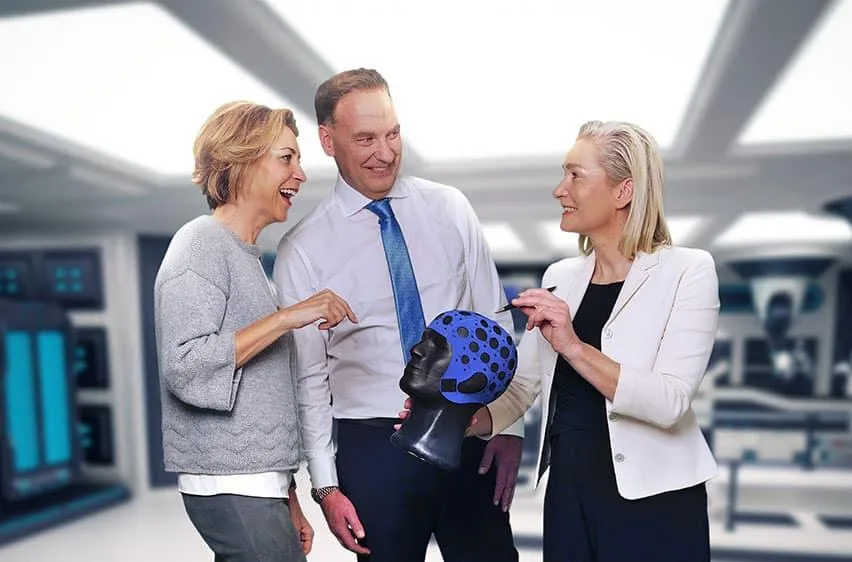
Illustration 1: Dr. Eva Otzen, patient and faculty member at the Institute
As a lecturer, she and her team of professionals educate prospective therapists exclusively on the most modern and only medically certified devices that have proven themselves at leading clinics and universities for the research and treatment of complex disorders. Her institute is the only one in the world that offers combined training in biofeedback and neurofeedback in a diploma course in German, English and French recognized by Swiss health insurers.
In this essay Dr. Eva Otzen gives a brief overview of her work with neuro- and biofeedback in general followed by a short study on the impact of transcranial neurofeedback on bio-physiological markers.
Improved Stress Resilience With Bio- and Neurofeedback
If people perceive a situation as challenging or even dangerous, or if they fear losing their status due to a conflict, they react with a physiological stress reaction, e.g. increased pulse, damp and cold hands, muscle tension, shallow, rapid breathing, an overexcited brain that leads to tension and insecurity or aggression. The body responds in this way because it thinks it can master the challenge or danger well or even survive it: In this case, the sympathetic part of the peripheral nervous system is dominant and releases energy to put the body in a state of fight or flight. Once the danger has disappeared, the sympathetic stress reaction weakens again (auto-regulation) and the body signals regenerate again under the influence of the parasympathetic system. However, if the person already has a weakening parasympathetic nervous system, he is unable to recover from the stress reaction of his body, so that the stress axis becomes chronic, resulting in excessive demands, exhaustion, hypersensitivity or (chronic) illness.
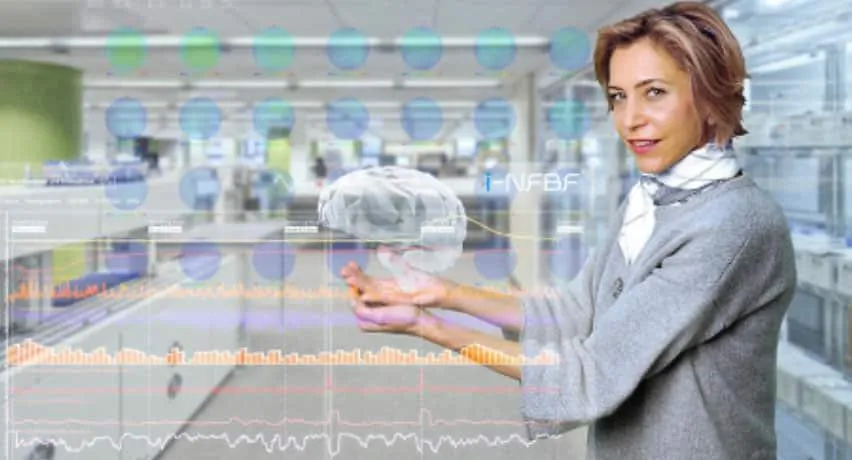
Illustration 2: Only entrust your brain to an expert!
Patients need to know that it is perfectly natural for the brain and body to respond to stress. Blood pressure, heartbeat, respiratory rate and the level of excitement in the brain increase under stress. Nature has arranged it in such a way that a healthy person can achieve top performance under great challenges. In this case, subconsciously controlled reactions are mobilized, which enable the body to react appropriately to the situation, and survive the situation in a healthy way, and then slide back into a relaxation phase.
“With bio- and neurofeedback, a patient can relearn the ability to respond adequately to stress or relaxation.”
DR. EVA OTZEN-WEHMEYER
However, these autonomous reaction are often overridden and can get out of hand. This affects the autonomic regulation so much that the body is no longer able to switch back and forth between tension and relaxation depending on the situation. The so-called resilience is lost. Chronic stress, i.e. the inability to recover from stress reactions, inevitably leads to stress-related dysfunction of the body. These include exhaustion, burnout, pain, auto-immune problems, irritability, anxiety, emotional blocks, memory disorders. With bio- and neurofeedback, a patient can relearn the ability to respond adequately to stress or relaxation. In particular, he will learn to strengthen the parasympathetic branch of the peripheral nervous system.
What is Biofeedback
Biofeedback is a scientifically recognized, highly effective and non-invasive therapy and training method of empirical medicine for making visible and providing feedback on specific, normally unconscious body functions (e.g. breathing, oxygen content, muscle tension, body temperature, pulse frequency, skin resistance, level of excitation in the brain, etc., which are important for recovery, well-being, and performance.)
Using computer-aided technical devices equipped with sensors, unconscious neurophysiological vital functions are reported back to the patient audio-visually or tactilely. “Feedback” means returning information. The results of the measurement are thus continuously reported back to the body almost instantaneously.
A therapist operates the biofeedback device and supports the patient in gaining knowledge and control over his or her vital functions. Therapists have extensive knowledge of unfavorable psycho-physiological activation patterns in certain diseases, and in the first phase they analyze the patient’s neuro-physiological profile and look for deviations or instabilities from the norm. They then correlate the results with the patient’s complaints / symptoms, link them to the information from the patient’s anamnesis, then develop a personalized and individualized treatment plan. The measurement results are discussed with the patient so that he or she understands the effects and connections between their physical processes and mental or emotional reactions and the actual causes of his or her complaints / symptoms (conveying the psycho-physiological connections). Then the therapist discusses a bio- and neurofeedback therapy plan with the patient. The therapy plan is used to improve the patient’s stress parameters that cause symptoms over several therapy sessions.
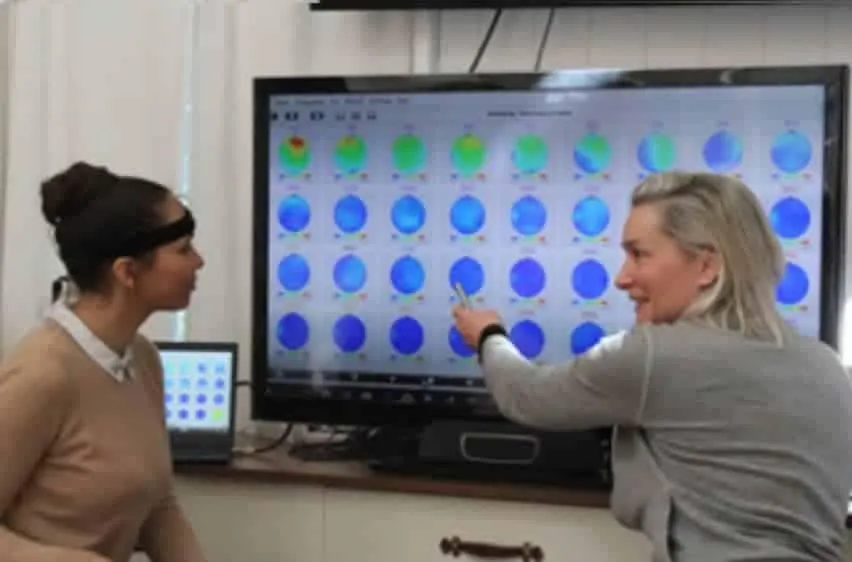
Illustration 3: Dr. Otzen educates a patient on her own brain activity
In the following ‘training’ phase, the therapist works out individual strategies with the patient on how he or she can specifically influence or stimulate health-promoting processes in their body. With biofeedback, as the therapist and patient can follow their progress on a screen, the most suitable strategy can be found quickly. This has a motivating effect on the patient, as they learn through trial and error. This method quickly leads to sustainable success (degree of target achievement). The patient perceives how he or she reacts to stress or relaxation, and learns how to respond. For example, during relaxation training, the depth of relaxation is measured and reported back in real time on the computer screen.
This enables an objective assessment of how far the relaxation has progressed, and which relaxation exercise fits the patient’s individual relaxation profile. The advantage over other, non-biofeedback supported relaxation techniques is that the biofeedback exercises are individually tailored to the patient and the patient can follow his or her progress / success in the form of facts and curves in real time on the computer screen in a concrete and objective manner. This type of motivational guidance means that only a few patients stop their therapy prematurely.
The therapist also carries out follow-up checks, determines the level of difficulty of the biofeedback exercises in which optimal learning success is achieved, and adapts the training situation to the patient’s real, everyday stressors. After a few sessions, the patient consolidates his or her abilities by recognizing and controlling their vital functions. He or she internalizes the exercises to such an extent that, even without a feedback device, they become gradually able to maintain their newly learned regulation skills in their everyday environment.
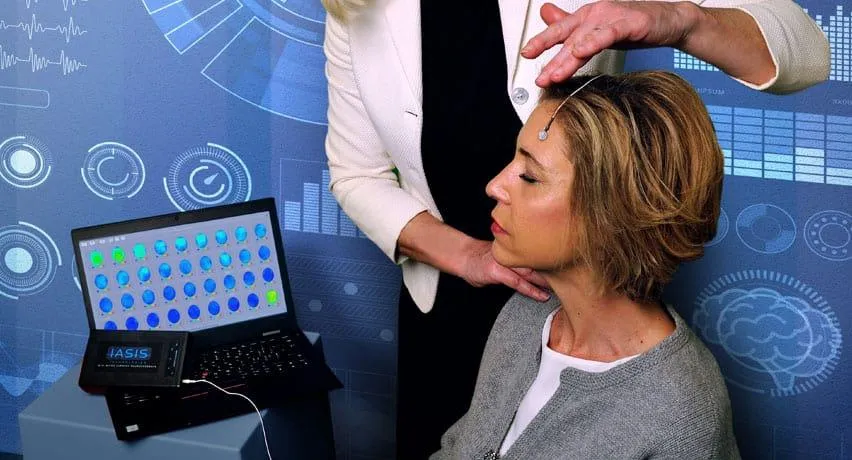
Illustration 4: Dr. Otzen trains a patient with IASIS Microcurrent Neurofeedback
The objective and scientific approach, direct feedback in real time, active role of the patient, targeted improvement of self-perception, insight (interoception) and the learning of strategies to control one’s stress parameters within a short time cause lasting changes in thinking, emotions, as well as conscious and subconscious behavior.
The way in which the feedback is designed (e.g. relaxation music), which parameters are reported back (e.g. brain waves in the alpha-theta range) and what role the therapist takes in the session have a strong influence on how lasting the patient’s experiences are. With neurofeedback in particular, by skillfully selecting the treatment points in the parietal or occipital area of the skull, brainwave constellations can be promoted in a targeted manner, which very quickly puts the patient in a meditative or even extremely deeply relaxed state in which he or she can experience trance phenomena, which help with trauma processing or self-healing.
Biofeedback can counteract destabilization and improve the patient’s self-regulation ability and thus resilience. An additional aspect that is important for salutogenesis is the experience of self-efficacy. Patients who feel helpless at the mercy of an illness or pain experience that they can do something about it and regain control. Through biofeedback, the helpless passive patient becomes an empowered, active agent with the expectation of self-efficacy.
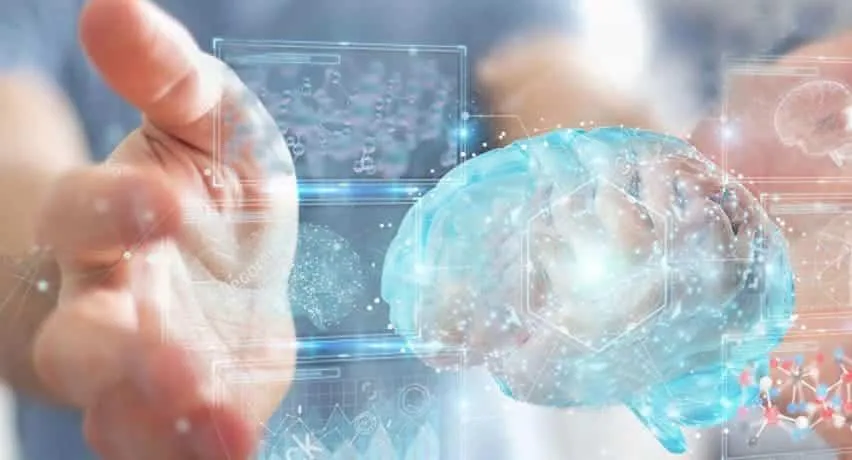
Illustration 5: At the I-NFBF we gently take care of your brain
Numerous controlled studies have shown that biofeedback is a learning process through which patients quickly gain voluntary self-control over their physiological system, and can then transfer it to everyday situations even without a feedback device.
Typical disorders in which biofeedback can be used for healing, prophylaxis and performance enhancement and where lasting therapeutic effects can be expected:
Stress Management and Relaxation Training:
Stress patients learn to breathe regularly deeply in the abdomen in order to relax in stressful situations. HRV biofeedback, in which patients learn to influence their breathing or their heartbeat – for example, by breathing in and out according to a certain pattern and rhythm – can be used to improve a patient’s resistance to stress. Since the skin conductance can be viewed as a direct measure of stress and relaxation, the patient learns – supported by music – to let go step by step and relax. Biofeedback is often used to first make patients and clients aware of excessive stress, since chronic stress can block one’s access and awareness of the body’s signals. This also applies to patients with cardiovascular diseases and high blood pressure.
Since anxiety patients have abnormal breathing parameters, breath biofeedback can be used as supportive therapy as part of treatment to help keep patients calm and thus reduce the likelihood of panic attacks. Once the relaxation exercises have been internalized, exposure training can begin. During the biofeedback session, fear-inducing content is presented with the help of movies or other image material, and the patient’s level of stress is visualized. The patient is then instructed by the therapist to use precisely the relaxation exercise that he or she has already mastered well, in order to enter a state of relaxation even in stressful situations. In this way, fear and avoidance behavior is reduced or even completely resolved and the patient’s willingness to confront the stressor is increased.
Pain Therapy:
Muscle biofeedback training helps to relax chronically tense muscles and relieve pain (e.g. tension in the back or shoulder muscles, spasticity or in the case of temporomandibular disorders). Patients learn to break the vicious circle of pain and muscular tension by means of visual or acoustic feedback.
Muscle Rehabilitation:
Muscle biofeedback training helps to restore muscle strength after accidents or paralysis.
Migraines and Tension Headaches:
Hand warming training is used to show patients with migraines how they can influence their blood vessels through relaxation and thus prevent migraine attacks.
In the case of chronically cold extremities (e.g. those caused by Raynaud’s Syndrome), temperature biofeedback can be used to improve blood circulation by warming the hands.
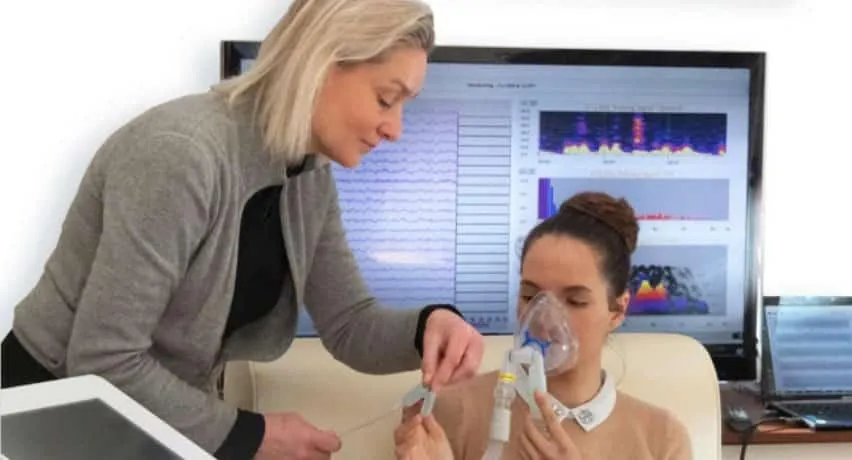
Illustration 6: Dr. Eva Otzen treats a patient with respiratory deficiency.
What is IASIS Micro Current Neurofeedback
Biofeedback, which is used for brainwave training, is called EEG biofeedback or neurofeedback. Neurofeedback is a highly efficient innovative variant of biofeedback that works with brain wave images and directly impacts the central nervous system, which is superordinate to the autonomic nervous system like a command center.
It enables the patient to perceive the degree of activity in his or her brain activity and to regulate it themself.
The associated reorganization of the brain waves and the re-networking of the neurons (neuroplasticity) leads to an improved efficiency of the brain activities. From a thermodynamic point of view, the brain as a whole attains a more energetically efficient state, i.e. it requires less energy supply (such as ATP) for the same cognitive work. One positive result is that the patient begins to feel better, with improvements to their well-being and behavior, as both the brain chemistry and the neural network in the brain change positively.
Today, neurofeedback methods are used for numerous neurological and psychiatric symptoms and illnesses: Attention Deficit Hyperactivity Disorder (ADHD), learning blocks, autism, sleep disorders, migraines, emotion regulation disorders, memory disorders, traumatic brain injury, stroke, burnout, tinnitus, brain fog with chemotherapy and even anxiety and panic disorders.
Addiction patients can use neurofeedback to learn to calm down the addiction centers in their brain and learn to avoid addictive behavior.
Patients with attention deficit, hyperactivity or learning deficits or blocks (e.g. dyscalculia, dyslexia) can positively influence the either over- or under-activated brain areas that are responsible for cognitive efficiency and concentration or attention.
There are different variants of neurofeedback procedures, and I would like to explain two of these in more detail: i) classic or indirect neurofeedback (see ill. 7) and ii) direct neurofeedback (see ill. 8).
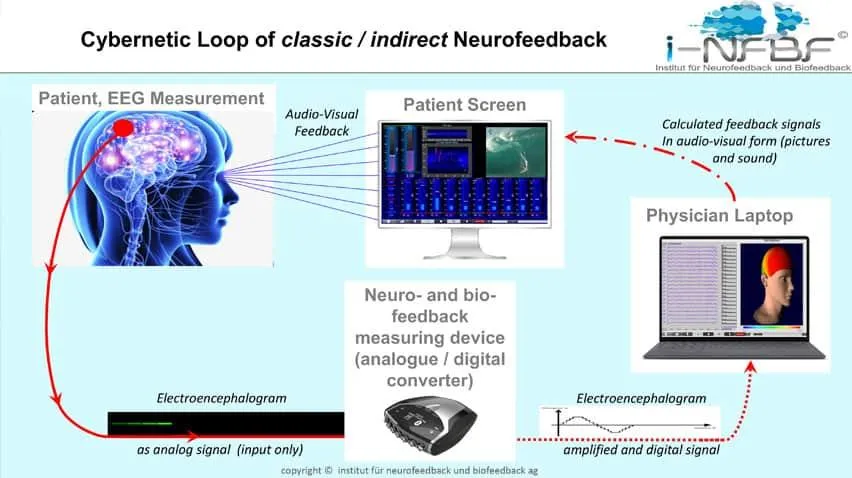
Illustration 7:Classic Neurofeedback Illustrated
With classic neurofeedback, the patient only receives feedback through visual and / or auditory perceptions. The classic neurofeedback aims to reach states of consciousness (relaxation, concentration or focus) by modulating the brain wave amplitudes by reporting back the attainment of the desired state of consciousness audio-visually or tactilely.
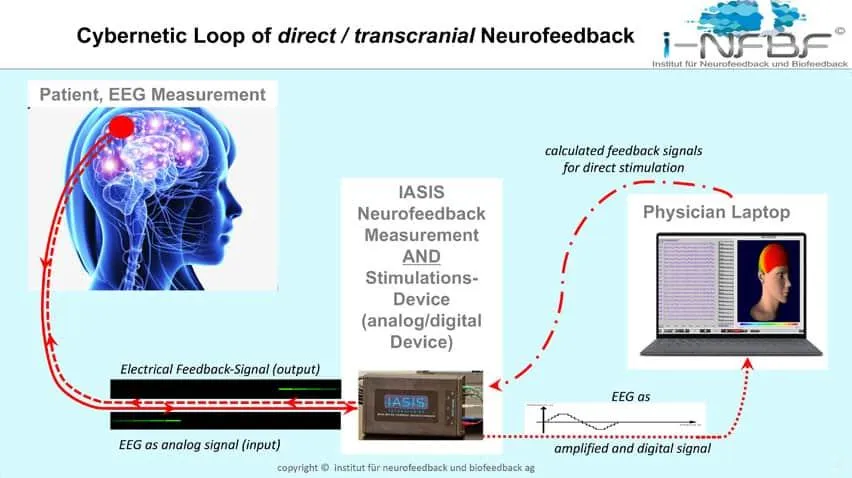
Illustration 8: Direct/Transcranial Neurofeedback Illustrated
Direct neurofeedback, also called transcranial neurofeedback, is a system in which a device gives feedback directly to the patient’s brain by means of a current pulse or magnetic pulse.
The patient is not addressed here through his or her own sensory perception, but through electrical or magnetic impulses.
IASIS Micro Current Neurofeedback uses electrical small impulses. The IASIS micro current neurofeedback is an innovative variant of the transcranial neurofeedback. I demonstrated this system at the IKN Conference in Germany titled “Healing the Brain” in August 2020. The EEG measuring electrodes mounted on the scalp of the patient also emit the finest microcurrent impulses that are tailored to brainwave activity. They are in the magnitude of 1/100s of an AA battery. Therefore, these impulses are of exceptionally low energy. Our assumption is that the micro current induced to the first neurons after travelling through the skull skin and bone are in a homeopathically low level of energy. We assume further, that these micro currents are on an energy level low enough to enter into the neurons’ communication. A scientific model explains the effect as follows: The brain recognizes the irregular micro-alternating current flowing into the transcranial system as an electrical impulse that is similar to that of neurons. However, the frequencies and amplitude changes are alien to the brain, so that the brain cannot classify them. In a figurative sense, this means that an incomprehensible “foreign language” suddenly flows inside one’s brain. The brain reacts by making its neurons desperately try to learn this new “language” (aka, this new frequency pattern) in order to be able to communicate on this microcurrent frequency as well. This leads to old neuron communication leaving its original, established frequency patterns in the brain in order to look for new patterns. This, in turn, leads to a reorganization of neural communication in terms of frequencies but also of pathways, i.e. it also creates new neural “highways” between neurons – referred to as neuroplasticity in neuroscience.
Barry Bruder, the Co-founder of IASIS Technologies and developer of IASIS Micro Current Neurofeedback, describes this change in neurological patterns in the brain in analogy to computer science. He calls it rebooting a “frozen” computer. Similarly, to a computer reboot, a person’s brain activity is restarted and rebalanced very gently. There is a restart in the brain for better mental health, well-being, willingness to learn and performance.
This learning process is repeated in several IASIS Micro Current Neurofeedback sessions, resulting in the brain becoming permanently calibrated and stabilized. The symptoms gradually recede over the course of therapy and the trainee can fully experience his or her life again.
The Clinical Effectiveness of Bio- and Neurofeedback in General:
The Association for Applied Psychophysiology and Biofeedback (AAPB) and the Society for Neuronal Regulation regularly examine the clinical evidence / effectiveness of BF and NF.
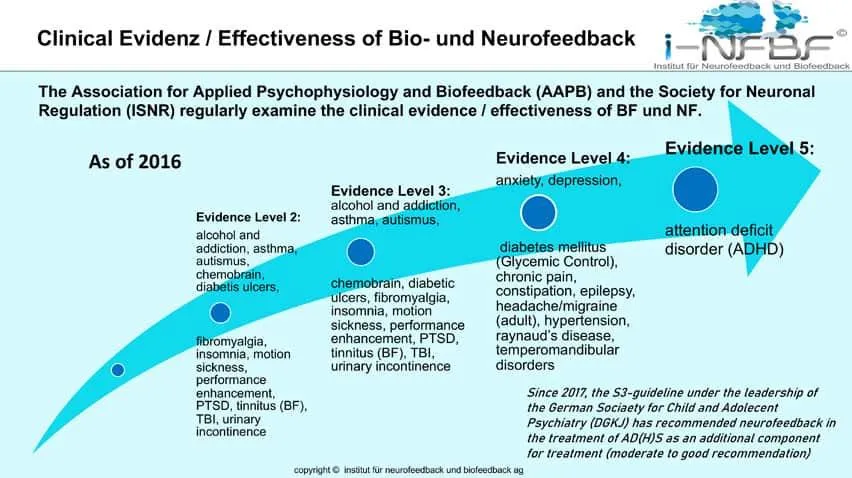
Illustration 9: History of Proven Effectiveness of Bio and Neurofeedback
The evidence base for Attention Deficit Hyperactivity Disorder (ADHD) has been raised to the highest evidence level 5 since 2016
Anxiety, diabetes mellitus (glycemic control), chronic pain, constipation, epilepsy, headache / migraine (adult), hypertension, Raynaud’s Syndrome, and temperomandibular disorders have advanced to a remarkably high level (4th level).
Level 3 includes: Alcohol and addictions, asthma, autism, chemo-brain, diabetic ulcers, fibromyalgia, insomnia, motion sickness, performance enhancement, Post-Traumatic Stress Disorder (PTSD), tinnitus (BF), TBI, urinary incontinence
Since 2013, bio and neurofeedback have moved up to level 2 (good support or good opportunity for change) on the list of recommendations of American doctors.
Conclusion from the study situation: With over 20,000 studies in the USA alone, bio- and neurofeedback are now scientifically well-documented and secured procedures that have shown a very high level of treatment success. Bio- and neurofeedback are progressive learning strategies with 4 learning phases (see ill. 10: reorganization, automation, stabilization, performance improvement).
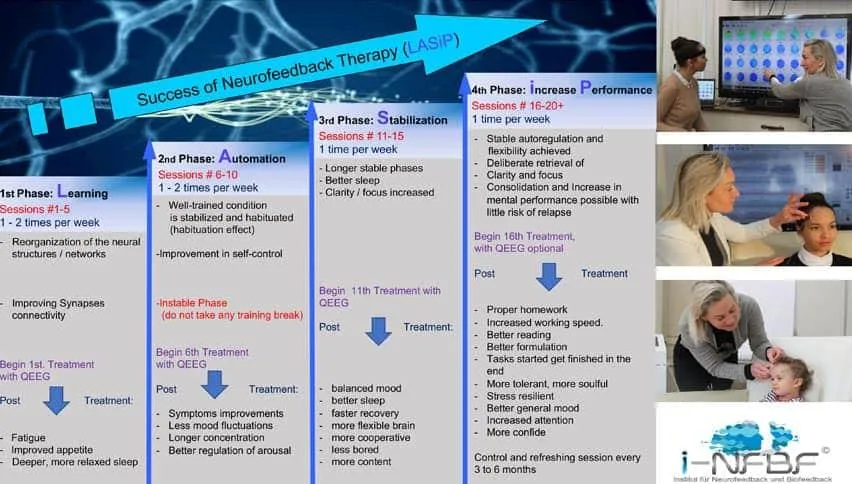
Illustration 10: Neurofeedback Training Program
Depending on the severity of the symptoms (stress, functional disorder, or even degenerative disease), several successive sessions are necessary:
Biofeedback 5-10+ sessions
Neurofeedback 15-20+ sessions
Biofeedback creates results faster than neurofeedback, but the patient only acquires relaxation and relaxation techniques. Neurofeedback takes longer, but is more appropriate for addressing neurological problems and if relaxation is not sufficient, such as with patients who have ADHD. A simultaneous combination of neurofeedback and biofeedback brings faster therapeutic success for both children and adults. In the short term, bio and neurofeedback appear to be costly. However, in the long term bio- and neurofeedback are cheaper than drug treatments whose discontinuation means a return of the symptoms.
Transcranial Neurofeedback: IASIS Micro Current Neurofeedback in Research:
Several neuroscientific studies have shown that people with anxiety, Post-Traumatic Stress Disorder (PTSD), and other neurological disorders have inappropriate delta brainwave activity.
The IASIS Micro Current Neurofeedback system has been shown to reduce or even eliminate inappropriate delta brainwave activity. This could be demonstrated by means of brain scans that were recorded before and after IASIS Micro Current Neurofeedback treatments.The Department of Radiology at the University of California at San Diego (UCSD) and the US Department of Veterans Affairs piloted studies of IASIS Micro Current Neurofeedback in 2017.
They took magnet encephalography images before and after treatments to demonstrate the effect of this method on brain abnormalities in patients with traumatic brain injury. They saw a 54 percent reduction in abnormalities and a 53 percent reduction in symptoms associated with traumatic brain injury. The patients recorded improvements in headache, sleep disorders, anxiety disorders, stuttering, hypersensitivity, tobacco consumption, memory, focus and concentration, and frustration resilience.
Excerpt from two case studies by Dr. Eva Otzen:
It is fascinating how learning processes are set in motion by bio- and neurofeedback in patients and improve interception, auto-regulation, and enable sustainable treatment success. In my practice, I often combine bio- and neurofeedback with hypnosis and photo-bio-modulation in order to solve behavioral blockages and to steer the energies released by neuro- and biofeedback in the right direction. The combination of these methods also shortens the duration of treatment.
I like to give insight in two interesting cases from my practice:
I treated a 65-year-old patient with high blood pressure with IASIS Micro Current Neurofeedback for 2 consecutive days. Throughout the treatment, 5 parameters of her physiology were monitored to determine how the body reacts to the IASIS Micro Current Neurofeedback treatment. The result was significant: Immediately after the onset of micro-current stimulation, there was a strong relaxation reaction, which can be read off the parameters heart rate and variability, breathing frequency and depth, skin conductance, and carbon dioxide content (CO2 content) of the exhaled air left (see ill. 11 and ill. 12).
The patient reported that she felt very comfortable and relaxed within a few minutes. Initially, a certain tiredness had developed, but this turned into a relaxed wakefulness towards the end of the treatment. The following night she slept very deeply and felt more rested than usual when she woke up. The physiological changes during the neurofeedback session can be seen in the following images: Immediately after the start of the stimulation (1st continuous vertical line), the one shows sloping and calm gradual skin conductance as well as deep, regular breathing create a strong relaxation response. The heart rate, which was initially around 83, was reduced to 68 beats per minute (see ill. 11).The heart rate variability, which reflects the interplay between the sympathetic and parasympathetic nervous system, i.e. the flexibility to switch between tension and relaxation, improved by 47.6% in the first few minutes of training (SDNN 21 compared to 31) (see ill. 11). The relaxation reaction perceived by the patient through the neurofeedback was clearly reflected in her physiology. The result of the first session could almost be reproduced in the second session with the exception of the vasodilation (compare ill. 11 with ill. 12).
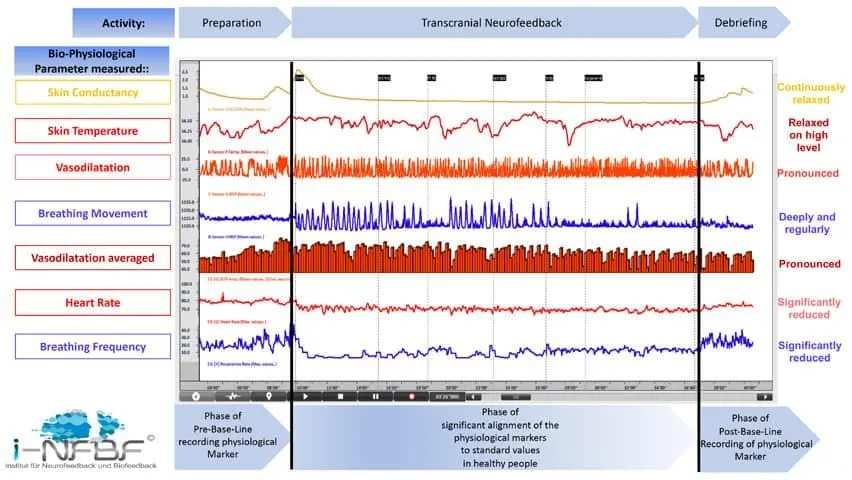
Illustration 11:Physiological profile during the 1st Neurofeedback Session
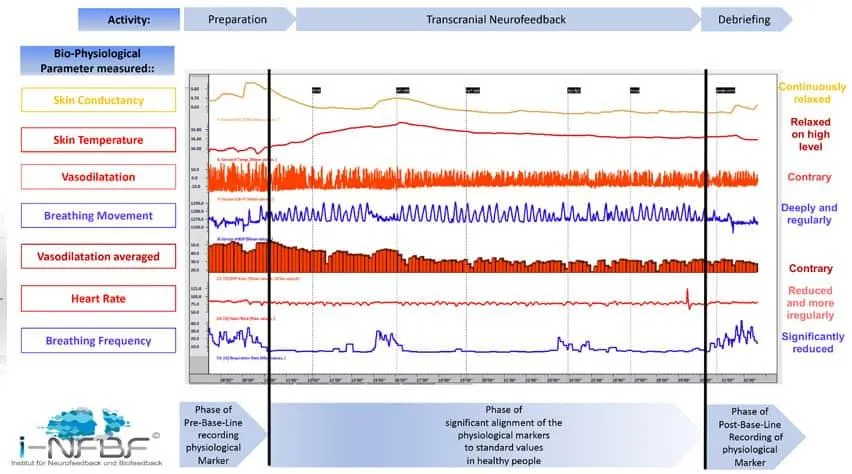
Illustration 12:Physiological Profile During the 2nd Neurofeedback Session
In another patient who suffered from a burnout problem following a COVID infection and a loss of smell and taste, I found that CO2 saturation was too low through capnography. Too low a CO2 concentration in the blood is unhealthy for the body. If the partial pressure is 35mmHg, the blood becomes too alkaline. This hypocapnia leads to vasoconstriction of the brain and thus to suboptimal neuronal activities, which can lead to overexcitation of nerves and muscles in particular.
Before the treatment, her CO2 saturation had already been reduced due to breathing too quickly, and was constantly below 35 mmHg. When asked about an emotionally stressful topic, her CO2 value fell alarmingly to around 25 mmHg. At the same time, her skin conductance became restless and her heart rate variability decreased drastically, which amounts to a weakening of the parasympathetic system. Immediately after the start of the neurofeedback session the CO2 value recovered to a normal level without my having given the patient any instructions for improved breathing technique.
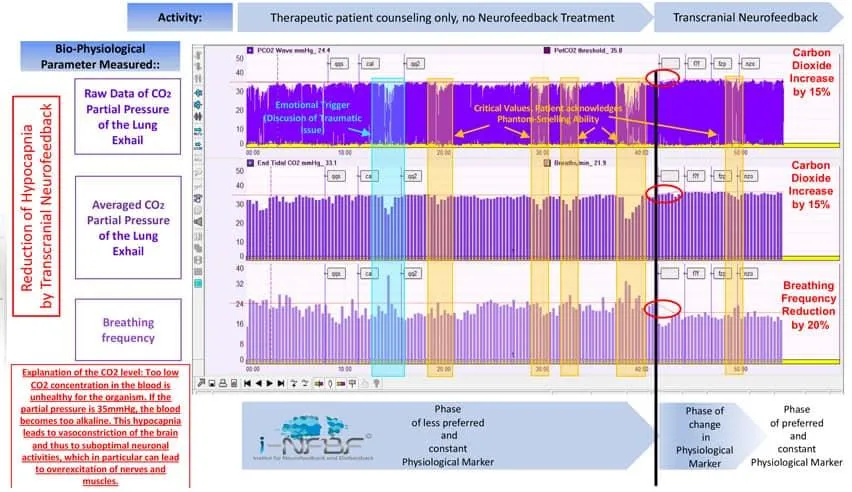
Illustration 13: CO2 & Respiratory Activity Measurement During the Neuro and Biofeedback Session
The patient also reported to me that she occasionally noticed ’phantom smells’ at home (e.g. the smell of gas). Together we were able to observe on the computer screen that she always perceived ’phantom smells’ as soon as her CO2 content fell below 33 mmHg. In the following sessions, the patient learned a breathing technique geared towards her personal neurophysiological needs which raised her CO2 content to a good, normal level. She practiced this several times a day at home, especially whenever the “phantom smell” reappeared. After 12 sessions of neurofeedback, her sense of smell returned to normal. After another 4 sessions, there was an improvement in her sense of taste, which we are currently still working on. She was very tired after every neurofeedback session. A few hours later, however, she felt healthier and much more energetic. These effects only lasted a few hours at first. After further neurofeedback training sessions and daily breathing exercises, she told me that the effects had lasted for up to a week. I did not expect IASIS Micro Current Neurofeedback to have such an instant effect. However, further research needs to be conducted among a large group of patients using a standardized treatment plan to show that biophysical markers can turn into healthy territory for a sustainable period of time.
Emotional Freedom Technique (EFT/Tapping)
What is EFT?
Emotional Freedom Technique (EFT), also known as “tapping,” is a gentle, evidence-based mind-body method that helps reduce stress, anxiety, emotional pain, and even physical symptoms. EFT combines elements of traditional Chinese acupressure and modern psychology by having you tap on specific meridian points on the body while focusing on a troubling thought, emotion, or memory.

How Does EFT Work?
Tapping on acupressure points sends calming signals to the brain, particularly the amygdala (the part responsible for the fight-or-flight response).
While tapping, you focus on a specific issue and use simple verbal statements, which helps process and release emotional blocks.
This process can quickly reduce the intensity of negative emotions, rewire stress responses, and promote a sense of calm and clarity.
What Can EFT Help With?
While it is not a medical treatment, we have seen improvement and sometimes full resolution in the areas of:
-Stress and overwhelm
-Anxiety and panic attacks
-Fears and phobias
-Traumatic memories and PTSD
-Chronic pain and physical symptoms
-Limiting beliefs and self-sabotage
-Performance anxiety (public speaking, sports, etc.)
-Cravings and unhealthy habits
What Does a Session Look Like?
You’ll be guided to identify a specific issue or feeling.
Together, you’ll rate the intensity of the feeling (0–10 scale).
You’ll tap with your fingertips on a series of points on your face and upper body while repeating simple phrases.
After a few rounds, you’ll check in to see if the intensity has changed, and continue as needed.
Most people feel calmer, lighter, and more empowered after a session.
Is EFT Evidence-Based?
Yes! EFT has been studied in clinical settings and is recognized as an effective, safe, and non-invasive technique for a variety of issues.
Key Research Highlights
Anxiety:
A meta-analysis of 14 studies found that EFT significantly reduced anxiety scores compared to control groups.
Clond M. Emotional Freedom Techniques for Anxiety: A Systematic Review With Meta-analysis. J Nerv Ment Dis. 2016 May;204(5):388-95. doi: 10.1097/NMD.0000000000000483. PMID: 26894319.
PTSD:
A randomized controlled trial with veterans showed that 86% of those who received EFT no longer met criteria for PTSD after six sessions, compared to 4% in the waitlist group.
Church D, Hawk C, Brooks AJ, Toukolehto O, Wren M, Dinter I, Stein P. Psychological trauma symptom improvement in veterans using emotional freedom techniques: a randomized controlled trial. J Nerv Ment Dis. 2013 Feb;201(2):153-60. doi: 10.1097/NMD.0b013e31827f6351. PMID: 23364126.
Depression:
A review of 20 studies found that EFT produced significant improvements in depression symptoms, often comparable to cognitive behavioral therapy (CBT).
Nelms JA, Castel L. A Systematic Review and Meta-Analysis of Randomized and Nonrandomized Trials of Clinical Emotional Freedom Techniques (EFT) for the Treatment of Depression. Explore (NY). 2016 Nov-Dec;12(6):416-426. doi: 10.1016/j.explore.2016.08.001. Epub 2016 Aug 18. PMID: 27843054.
Physiological Effects:
Studies show that EFT can reduce cortisol (the stress hormone) and improve heart rate variability, indicating a real impact on the body’s stress response.
Stapleton P, Church D, Sheldon T, Porter B, Carlopio C. Depression symptoms improve after successful weight loss with emotional freedom techniques. ISRN Psychiatry. 2013 Jul 28;2013:573532. doi: 10.1155/2013/573532. PMID: 23984182; PMCID: PMC3747476.